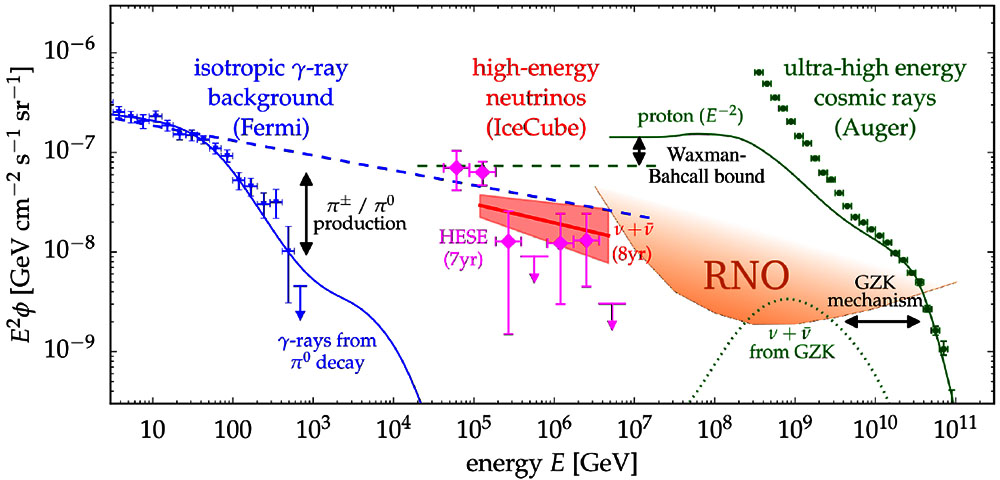Science
|
Science
The field of radio detection of high-energy cosmic particles has been growing rapidly over the past decade. Radio Neutrino Observatory (RNO-G) capitalizes on the success and combined expertise of the ARA, ARIANNA, ANITA and RICE experiments, for a design that will deliver world-leading measurements of the high-energy neutrino flux, with the pointing and energy resolution required for multi-messenger astronomy, aligned with the Astro2020 Science whitepapers. Within RNO-G, we will also develop critical hardware for the radio component of IceCube-Gen2. We foresee 35 stations to be deployed at Summit Station in Greenland. Each station will have a surface component and a deep component (100 m below the surface of the ice) that together enable the detection and detailed reconstruction of neutrino events. The Radio Neutrino Observatory Greenland (RNO-G) With the discovery of a diffuse flux of astrophysical neutrinos and the identification of a multi-messenger source candidate, the success of IceCube has established neutrinos as a powerful messenger in the exploration of the high-energy universe. RNO-G will extend multi-messenger neutrino astronomy to energies above 10 PeV. RNO-G is designed around a broad multi-messenger astrophysics program to be an instrument that measures of order ten neutrinos at the highest energies, possibly including the first discovery. The RNO-G collaboration will develop the techniques required to rapidly produce and respond to alerts of astrophysical transients. A Pathfinder for IceCube-Gen2 Radio Building on ARA and ARIANNA experience, the initial RNO-G stations will combine the strengths of all previous approaches. RNO-G will enable the determination of the optimal station depth, the relative fractions and arrangements of surface and deep antennas, and the mode of power distribution that is the most feasible for the IceCube-Gen2 radio array envisioned at 500 km2 area. Studies with RNO-G will enable further development of simulations of radio arrays to be designed for and ready to handle an array of the size envisioned for IceCube-Gen2. Coordination between the RNO and IceCube-Gen2 collaborations and the interplay of the timelines and logistics of the two projects is in progress. RNO-G Science: the Highest Energy Neutrinos Neutrinos are unique messengers. They point back to their sources and can reach us from the most distant corners of the universe because they travel undeflected by magnetic fields and unimpeded by interactions with matter or radiation. Unlike γ-rays, which can be explained by inverse Compton scattering, the observation of high-energy neutrinos from these objects provides incontrovertible evidence for cosmic-ray acceleration, since both neutrinos and γ-rays are produced when cosmic rays interact with ambient photons or matter within their source. Resolving the sources of cosmic rays and the acceleration mechanisms will require a comprehensive multi-messenger program involving observations of cosmic rays, γ-rays, and neutrinos across many decades of energy. Solar Physics with RNO-G Solar Flare as observed with the RNO-G LPDAs on June 29 2022. For more details, see https://arxiv.org/abs/2404.14995 RNO-G monitors the radio background at Summit Station essentially at all times when the Sun is up. This makes RNO-G a powerful solar observatory that also records the time-domain signals, which is unusual for solar radio observatories.Solar Flare GalleryClick on the image to enlarge Glaciology with RNO-G Index of refraction of bulk ice as extracted from ground bounce measurements. The detector medium of RNO-G is the thick ice-sheet at Summit Station. In order to understand neutrino signals generated in and propagated through this ice, several dedicated measurements campaigns have and will take place. They will shed light on the ice parameters, such as attenuation length, scattering, index of refraction, and birefringence.Most recent glaciology publicationClick on the image to enlarge |



